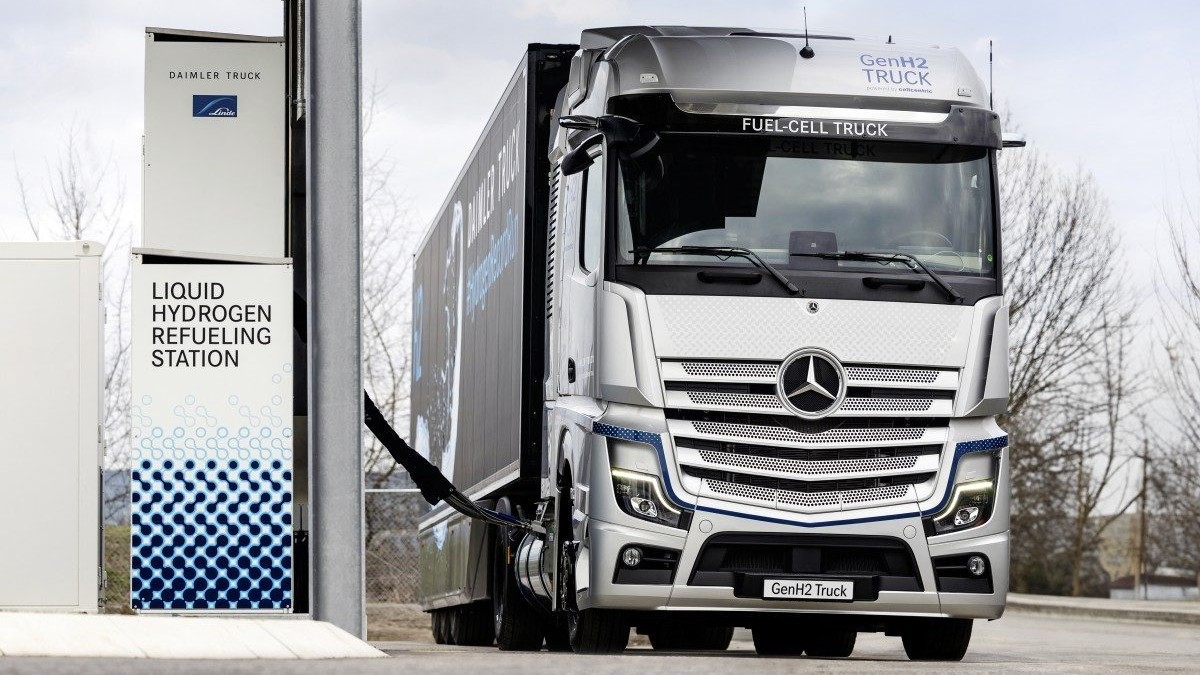Daimler Truck and Linde unveil sLH2

Daimler Truck and Linde Engineering have unveiled sLH2, a jointly developed refuelling technology for subcooled liquid hydrogen.
When compared to gaseous hydrogen, this innovative approach allows for a higher storage density, a greater range, faster refuelling, lower costs and superior energy efficiency.
Refuelling takes around ten to fifteen minutes for a 40-tonne heavy-duty truck, carrying 80kg of liquid hydrogen for a range of 1000km and more. At the same time, the new sLH2 technology lowers the required investment for a hydrogen refuelling station by a factor of two to three, and operational costs are five to six times lower. Today, liquid hydrogen can be supplied reliably throughout Europe.
Compared to regular liquid hydrogen (LH2) refuelling technology, the new process uses a new innovative sLH2 pump to slightly increase the pressure of the liquid hydrogen. With this method, the hydrogen becomes subcooled liquid hydrogen (sLH2). Hydrogen in this state facilitates a very robust fuelling process that also keeps energy losses during refuelling to a minimum.

Furthermore, no data transmission between the refuelling station and vehicle is necessary, which further reduces the complexity of the solution. At the same time, refuelling capacity is increased to new levels. The pilot refuelling station has a capacity of 400kg of liquid hydrogen per hour. In comparison to regular liquid or gaseous hydrogen refuelling concepts, sLH2 is considerably simpler while delivering increased performance.
Andreas Gorbach, Member of the Board of Management of Daimler Truck AG, responsible for Truck Technology, said, “Zero-emission transport needs three factors: the right battery-electric and hydrogen-powered vehicles, the required infrastructure network and cost parity for ZEVs compared to diesel trucks.
“In terms of vehicles, the transformation is in full swing. In terms of hydrogen infrastructure, we are reaching a major milestone today: With sLH2, hydrogen refuelling becomes as convenient as today’s refuelling with diesel,” he said.
“It takes about 10 to 15 minutes to fuel our Mercedes-Benz GenH2 Truck for a range of more than 1000km. We now call on other OEMs and infrastructure companies to follow our approach and jointly make this technology an industry standard.”
Safe, fast and simple refuelling with hydrogen
In contrast to current liquid hydrogen (LH2) refuelling, the sLH2 process is similar to the convenience of current diesel refuelling technology. Due to robust insulation the refuelling hose and the design of the interfaces between the nozzle and fuel tank, the process is safe without the possibility of spillage. Therefore, the protective measures required for sLH2 refuelling are comparable to those required for diesel.
sLH2 to be implemented in Mercedes-Benz GenH2 Truck customer-trial fleet
From mid-2024 onward, five companies are expected to take part in initial customer trials to gain first experience in CO2-free long-distance transport with Mercedes-Benz GenH2 Trucks. The semi-trailer tractors will be deployed in different long-haul applications on specific routes within Germany, and they will be refuelled at the now open public sLH2 refuelling station in Wörth am Rhein and at a refuelling station in the Duisburg area.





